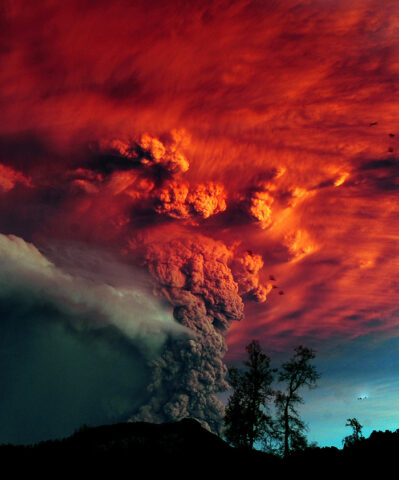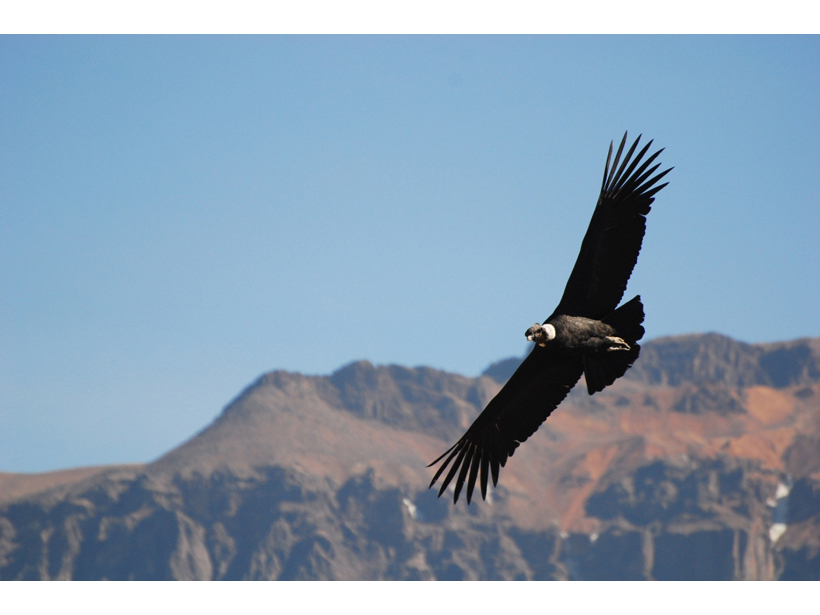It’s impossible to read a condor’s mind, but you’d think a fiery volcano pouring millions of tons of ash onto its home would make the bird turn tail and head for greener pastures. You’d also assume that if that same ash killed hordes of livestock—a carrion-eating condor’s main meal—it might take advantage of the carnage.

So it came as a big surprise to a group of behavioral ecologists when Chile’s nearby Puyehue–Cordón Caulle volcano complex suddenly erupted in 2011 and the Andean condors they were already studying neither fled nor feasted.
“The condors seemed not [to] have noticed that something [was] different around them,” Pablo Alarcón of the Universidad Nacional del Comahue in Argentina told Eos. He’s the lead author of a recent paper detailing the birds’ response—or lack thereof—to the eruption, which not only killed livestock but grounded flights around the world and threw Patagonian farmers into economic despair. “The condors’ response is not common in the ecological and behavioral literature,” Alarcón said. “How is it possible that condors had not escaped from those conditions?”
Alarcón and his colleagues published their observations in Behavioral Ecology last month.
Explosive Interruption
Prior to the eruption, scientists had already equipped 10 condors with electronic tags that allowed them to monitor the birds’ movements to better understand their breeding and other behavior. After the eruption began in June of 2011, the researchers tagged 10 additional birds and tracked their movements as well for the next 2 years using GPS data. They expected that the birds would avoid the huge ash plumes, abandon their mountain nesting sites altogether, or change their feeding patterns to target the areas where more dead livestock lay.
Because eastward winds pushed the ash over Patagonia, where the condors feed, “in this sense, foraging condors were inside the eruption,” Alarcón said.
The scavengers even ignored the smorgasbord of livestock carcasses that littered the steppe.
But while hundreds of thousands of cattle, goats, and sheep succumbed to blindness, tooth abrasion, digestive problems, and, eventually, death because of the abrasive ash, the condors flew head first, apparently unperturbed, through ash plumes between their nests high in the mountains and their feeding grounds along the Patagonian Steppe. The scavengers even ignored the smorgasbord of livestock carcasses that littered the steppe, instead regularly revisiting their usual feeding grounds.
Birds Versus Volcanoes
Research on how birds react to volcanic eruptions is thin. In 2010, researchers investigated seabird populations on Kasatochi Island in the Aleutians after the stratovolcano unexpectedly let loose in 2008 and covered some of the island in 30 meters of ash. The majority of bird species that did not perish immediately returned to the island after three major eruptions of the volcano but weren’t able to reproduce because their nesting grounds had been buried by ash. By 2009, the researchers found that only some sea lions and a few bird species remained on the island.
Similarly, the eruption of Mount St. Helens in 1980 in southwestern Washington state wiped out most of the surrounding wildlife, including several bird species that lived around the volcano—although some species were able to repopulate the area within days or weeks of the eruption.
Although researchers have studied how other bird populations react to volcanoes, this study is the first to track the movement of individuals before and following a catastrophic eruption.
Perception or Reaction?
Alarcón and his colleagues propose that the condors stayed true to their flight patterns and home ranges because finding new breeding and feeding grounds wasn’t worth the cost. Andean condors are social creatures, and mated couples raise only one chick every 2 or 3 years. Remaining in a familiar territory may be more important to them than avoiding potentially dangerous ash falling from the sky, the authors suggest.
Remaining in a familiar territory may be more important to them than avoiding potentially dangerous ash falling from the sky.
This explanation seems like a stretch to Charlie Crisafulli, an ecologist at the Pacific Northwest Research Laboratory in Olympia, Wash. He studies how animal populations react to and recover from natural disasters such as volcanoes, and he wasn’t involved in the research.
“[The authors] speak of the animal making decisions based on perception,” Crisafulli said, but the birds are merely “responding to immediate experiences,” such as pain.
A condor flying through an ash plume won’t change course unless its eyes are “burning like hell” or it experiences any number of other volcano-related discomforts, such as difficulty breathing due to choking ash, Crisafulli asserted.
Regardless, he said he considered the observations a solid contribution to a growing body of work on how organisms behave following a volcanic eruption.
Long-Term Prospects
The chance to observe condors affected by an eruption “fell right into their laps,” Crisafulli said of Alarcón and his team. “They took advantage of this opportunity by conducting a well-thought out and interesting study.”
How the birds will fare in the long run remains to be seen, Crisafulli noted—a question the authors also address in the paper. They raise the possibility that the condors exposed to the eruption might suffer long-term detriments such as silicosis (a lung disease) or chemical contamination.
—JoAnna Wendel, Staff Writer
Citation: Wendel, J. (2015), Birds ignore volcano blast, puzzle scientists, Eos, 96, doi:10.1029/2015EO036103. Published on 23 September 2015.

